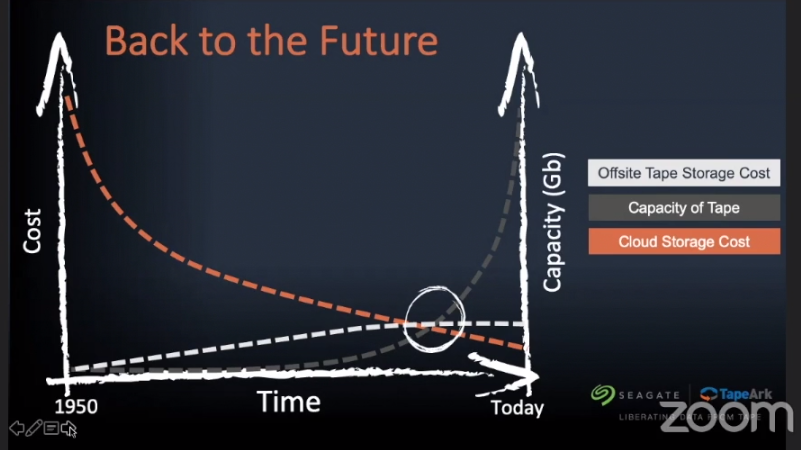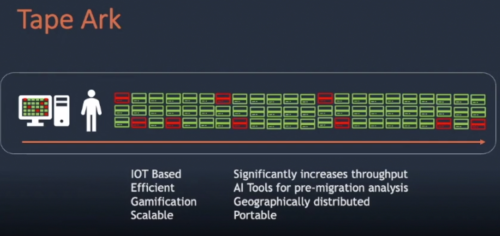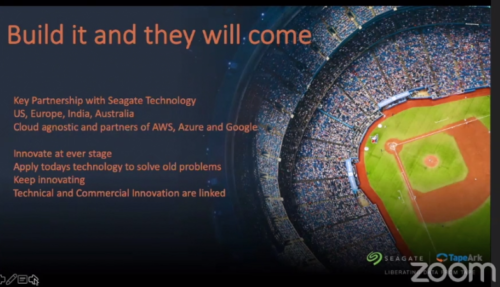
How Tape Ark Overcame Legacy Technical Challenges
Amid the rapid pace of technological advances and consumer viewing demands, media organizations have found themselves creating “work arounds” to address tape and other legacy IT infrastructure and systems.
Seagate Powered by Tape Ark has addressed these legacy challenges by moving highly valuable legacy content from traditional backup tape and data formats to the cloud in a process that is secure, safe, efficient and positioned for greater value, according to Kyle Evans, director of sales at Tape Ark.
Innovation is “part of our core fundamental beliefs — it’s part of what we do every day, all day,” he said during a May 27 presentation at the Hollywood Innovation and Transformation Summit (HITS) Live event.
“And our innovations are really helping our customers to innovate,” he said during the presentation “Breaking Through Legacy Technical Challenges: An Innovative Approach for your Most Critical Assets.”
He pointed to a quote from Albert Einstein that “really sums up the way we’ve gone about our challenge”: “You can’t solve a problem on the same level that it was created. You have to rise above it to the next level.”
What Einstein suggested is needed to solve a problem is “exactly what we’ve done” at Tape Ark, said Evans, who admitted to using several classic “cheesy movie lines” as part of his presentation.
He pointed to a graph showing what he said was the “historical challenge” that his company was “trying to solve.”
 Magnetic tape has been used across all industries since the 1950s, starting in low data volumes and then increasing in volumes significantly in recent years, he explained. The traditional approach when using tape was to have a storage management system that included an offline storage system and some kind of a tape vault in which the tape “sits in an air-conditioned room, where the customer pays a fee per month to store that content,” he noted. That fee started out small and then increased slightly over time, he pointed out.
Magnetic tape has been used across all industries since the 1950s, starting in low data volumes and then increasing in volumes significantly in recent years, he explained. The traditional approach when using tape was to have a storage management system that included an offline storage system and some kind of a tape vault in which the tape “sits in an air-conditioned room, where the customer pays a fee per month to store that content,” he noted. That fee started out small and then increased slightly over time, he pointed out.
While there were initially very low-density tapes, the density has increased in recent years. Still, however, most tapes in vaults today are low density, he said.
Cloud storage, meanwhile, “would have been horrendously expensive” in the 1950s,” but it has “decreased significantly” in recent years, he said. “Where the magic happens in our business” is where a “fundamental shift” happens in cost, he noted. In the case of “every tape created prior” to that point, if you were take the content off the tape and moved it to the cloud, it would be cheaper on a cost-per-gigabyte basis and that represents the “vast majority of backup tapes” – a little-known fact that is “fundamental to our business,” he told listeners, adding the “challenge [was] how do we get access to that?”
The lifespan of tape drives, meanwhile, was also an issue, he pointed out, noting they initially had a lifespan of about 15 years but, over time, they’ve become more obsolete more quickly and now have a lifespan of only about two years typically.
“Those customers who have been keeping tapes on a large variety of media over that longer period face a compounding problem where they have multiple formats plus a large number of tapes,” he said, adding: “We noticed that our customers were wanting to address this problem.” They saw the price of cloud was declining and there was an advantage they could see in moving their content there, he noted.
Tape Ark customers also knew there were emerging artificial intelligence (AI) and machine learning (ML) tools they wanted to apply to that content, and they wanted to move their workflows to the cloud, he said. However, doing that is not so simple and, “particularly with a diverse collection” that many customers have, “there’s some real challenges that come into play,” he noted.
He pointed to slides showing just how significant the savings can be for some customers, noting that, in one case, cloud storage of 1.5 million 9-track tapes would yield $9.6 million in annual sales over an off-site warehouse. Although the cost to store 10,000 LTO4 tapes would cost the same $6,000 a month under either system, he noted that there would still be three key advantages to cloud storage: No more off-site storage fees, no more hardware maintenance and all data would be addressable.
There have been a couple of setups to choose from: the typical, non-scalable setup and a robotic vertical scaling setup, he said. Robotic silos are “great for writing small amounts of data to and from, but they’re not really designed for mass migrations,” he noted. Users are also limited by the number of tape drives they have (typically 10-20), he pointed out.
“Trying to buy some legacy hardware to sustain a migration project is really quite challenging,” he added.
Tape Ark’s solution to overcome those challenges is a “story of innovation,” he said, adding: “This is the story of Tape Ark looking at every step of the process and trying to innovate to make it a lot more efficient, and taking that pain out of getting access to content.”
The company developed an Internet of Things (IoT)-based system using some AI tools that can handle a huge collection of tapes and scale for any size tape job, he told listeners, adding: “We’re built for scale and we scale according to each job.”
 Tape Ark knew that building the tech was one part of the project, but “building the business innovation was another part” of the project and that is why it partnered with Seagate, he noted.
Tape Ark knew that building the tech was one part of the project, but “building the business innovation was another part” of the project and that is why it partnered with Seagate, he noted.
Tape Ark is “cloud-agnostic” and partners with all major platforms, he went on to say, noting its goal is to “innovate at every stage.” The solution applies today’s technology to solve old problems and the company plans to keep innovating, he said.
Achieving “greater audience engagement” is one key reason why Tape Ark customers want to move to the cloud, he said, pointing to the “greater granularity” of data that can be achieved for the content they have. It also boosts the ability to license and monetize content, he said, adding that what is an “absolutely critical” factor is that content becomes much more accessible once it is in the cloud.
Other advantages include reduced editing time, while the addition of AI and ML enables various features including speech-to-text transcription and location and object identification, he noted.
He concluded by pointing to three key questions that media organizations should ask themselves: (1) Do they want to keep their content on aging physical tape or move it to the cloud and make all content accessible with significant redundancy? (2) Do they want their content stored out of reach or in the cloud enabling remote work? (3) Would they prefer to manually enter 1,000 data points with 100% accuracy or have 100 million data points in the cloud with 99% accuracy?
Click here for the presentation slide deck.
The May 27 HITS Live event tackled the quickly shifting IT needs of studios, networks and media service providers, along with how M&E vendors are stepping up to meet those needs. The all-live, virtual, global conference allowed for real-time Q&A, one-on-one chats with other attendees, and more.
HITS Live was presented by Microsoft Azure, with sponsorship by RSG Media, Signiant, Tape Ark, Whip Media Group, Zendesk, Eluvio, Sony, Avanade, 5th Kind, Tamr, EIDR and the Trusted Partner Network (TPN). The event is produced by the Media & Entertainment Services Alliance (MESA) and the Hollywood IT Society (HITS), in association with the Content Delivery & Security Association (CDSA) and the Smart Content Council.
For more information, click here.
